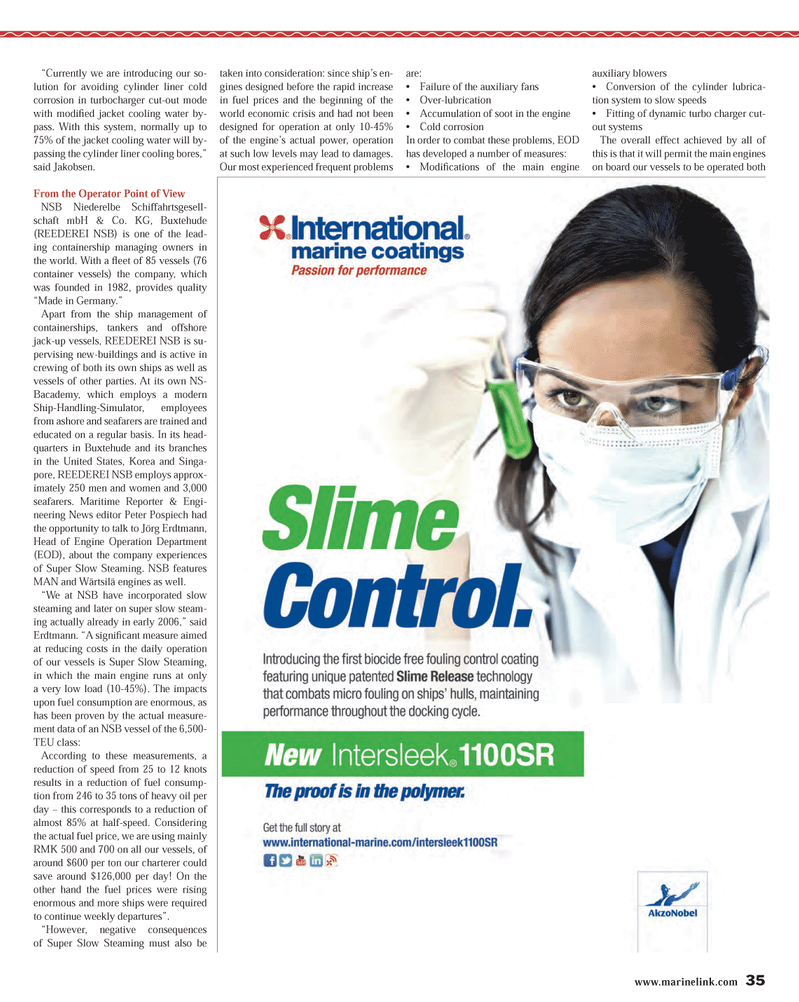
Page 35: of Maritime Reporter Magazine (November 2013)
Marine Propulsion Annual
Read this page in Pdf, Flash or Html5 edition of November 2013 Maritime Reporter Magazine
www.marinelink.com 35?Currently we are introducing our so-lution for avoiding cylinder liner cold corrosion in turbocharger cut-out mode with modiÞ ed jacket cooling water by- pass. With this system, normally up to 75% of the jacket cooling water will by-passing the cylinder liner cooling bores,? said Jakobsen.From the Operator Point of View NSB Niederelbe Schiffahrtsgesell- schaft mbH & Co. KG, Buxtehude (REEDEREI NSB) is one of the lead-ing containership managing owners in the world. With a ß eet of 85 vessels (76 container vessels) the company, which was founded in 1982, provides quality ?Made in Germany.? Apart from the ship management of containerships, tankers and offshore jack-up vessels, REEDEREI NSB is su-pervising new-buildings and is active in crewing of both its own ships as well as vessels of other parties. At its own NS- Bacademy, which employs a modern Ship-Handling-Simulator, employees from ashore and seafarers are trained and educated on a regular basis. In its head-quarters in Buxtehude and its branches in the United States, Korea and Singa-pore, REEDEREI NSB employs approx-imately 250 men and women and 3,000 seafarers. Maritime Reporter & Engi-neering News editor Peter Pospiech had the opportunity to talk to Jörg Erdtmann, Head of Engine Operation Department (EOD), about the company experiences of Super Slow Steaming. NSB features MAN and Wärtsilä engines as well. ?We at NSB have incorporated slow steaming and later on super slow steam-ing actually already in early 2006,? said Erdtmann. ?A signi Þ cant measure aimed at reducing costs in the daily operation of our vessels is Super Slow Steaming, in which the main engine runs at only a very low load (10-45%). The impacts upon fuel consumption are enormous, as has been proven by the actual measure-ment data of an NSB vessel of the 6,500-TEU class:According to these measurements, a reduction of speed from 25 to 12 knots results in a reduction of fuel consump-tion from 246 to 35 tons of heavy oil per day ? this corresponds to a reduction of almost 85% at half-speed. Considering the actual fuel price, we are using mainly RMK 500 and 700 on all our vessels, of around $600 per ton our charterer could save around $126,000 per day! On the other hand the fuel prices were rising enormous and more ships were required to continue weekly departures?.?However, negative consequences of Super Slow Steaming must also be taken into consideration: since ship?s en- gines designed before the rapid increase in fuel prices and the beginning of the world economic crisis and had not been designed for operation at only 10-45% of the engine?s actual power, operation at such low levels may lead to damages. Our most experienced frequent problems are:? Failure of the auxiliary fans ? Over-lubrication ? Accumulation of soot in the engine ? Cold corrosion In order to combat these problems, EOD has developed a number of measures:? ModiÞ cations of the main engine auxiliary blowers? Conversion of the cylinder lubrica- tion system to slow speeds? Fitting of dynamic turbo charger cut- out systemsThe overall effect achieved by all of this is that it will permit the main engines on board our vessels to be operated both MR #11 (34-41).indd 35MR #11 (34-41).indd 3511/12/2013 10:33:10 AM11/12/2013 10:33:10 AM

 34
34

 36
36
